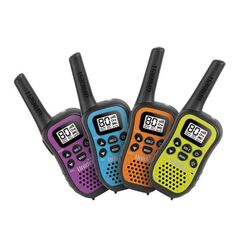UHF Radios
What our customers have to say about our UHF & CB radios
Real reviews from real adventurers
Reliable Comms for 4WD, Caravans and Camping
Shop UHF radios built for Australian conditions. From compact handhelds to powerful in-car units, our range covers everything you need for clear communication on and off the road.
Choose from leading brands like GME, Oricom, and Uniden, trusted by drivers across the country for quality and reliability. Add antennas, mounting gear, and accessories to build the perfect setup for your next trip.
At Outback Equipment you can find the right UHF radio for 4WDing, caravanning, or long-haul driving. With delivery across Australia, it’s never been easier to get your vehicle ready with gear you can count on.
Why You Need a UHF Radio
Good communication makes every trip smoother. Out on the highway or deep in the bush, a UHF CB radio keeps you in touch when phone reception disappears.
Drivers use them to share road conditions and hazards. Convoys rely on them to stay organised across rough tracks. Campers and caravaners use them to call for help or stay connected with the group.
Emergency channels are monitored across Australia, giving you a direct line if something goes wrong. Repeater stations extend range in hilly country, so you can reach others when it matters most. A UHF radio is simple, fast, and built for the kind of travel Australians do every day.
What Else Do You Need
- UHF Antennas & Mounting Brackets – Boost signal strength and improve clarity on long trips.
- Overhead Roof Consoles – Keep in-car radios secure and within easy reach.
- 4WD Recovery Gear – Be ready for tough tracks and unexpected situations.
- Dual Battery Systems – Power your UHF and other electronics on the road.
- Navigation & GPS Units – Match clear comms with reliable maps and tracking.
- Camping Lighting – Light up your site while staying connected.
Frequently Asked Questions about UHF Radios
How far can a UHF radio transmit in Australia?
Range depends on where you use it. In open country a handheld UHF can reach up to 10–15 km. In hilly or built-up areas the range drops to around 1–5 km. Vehicle-mounted units with an external antenna can reach 20–50 km or more in the right conditions.
Do I need a licence to use a UHF radio?
No licence is needed in Australia or New Zealand. UHF CB radios are free to use by the public. Just make sure you follow channel rules, especially for emergency channels, which are monitored nationwide.
What’s the difference between UHF and VHF radios?
UHF (Ultra High Frequency) radios are better at working through trees, hills, and buildings, which makes them ideal for 4WD, caravans, and general land use. VHF (Very High Frequency) radios carry further in open, flat areas but are mostly used for marine communication.
Are CB radios the same as UHF radios?
Yes. CB stands for Citizen Band radio. In Australia, CB radios are almost always UHF CB radios that run on 80 channels at 477 MHz. VHF CB exists but is rare and mostly for older or marine setups. If you’re shopping for a CB radio for 4WDing or caravanning, you’re looking at UHF.
Which UHF channels should I use when driving in convoy?
Channel 10 is the common convoy channel for 4WD groups. Channel 18 is used by caravanners. Truck drivers mostly use Channel 40 on highways. Always avoid 5 and 35 unless it’s an emergency, as these are reserved for emergency calls only.






































